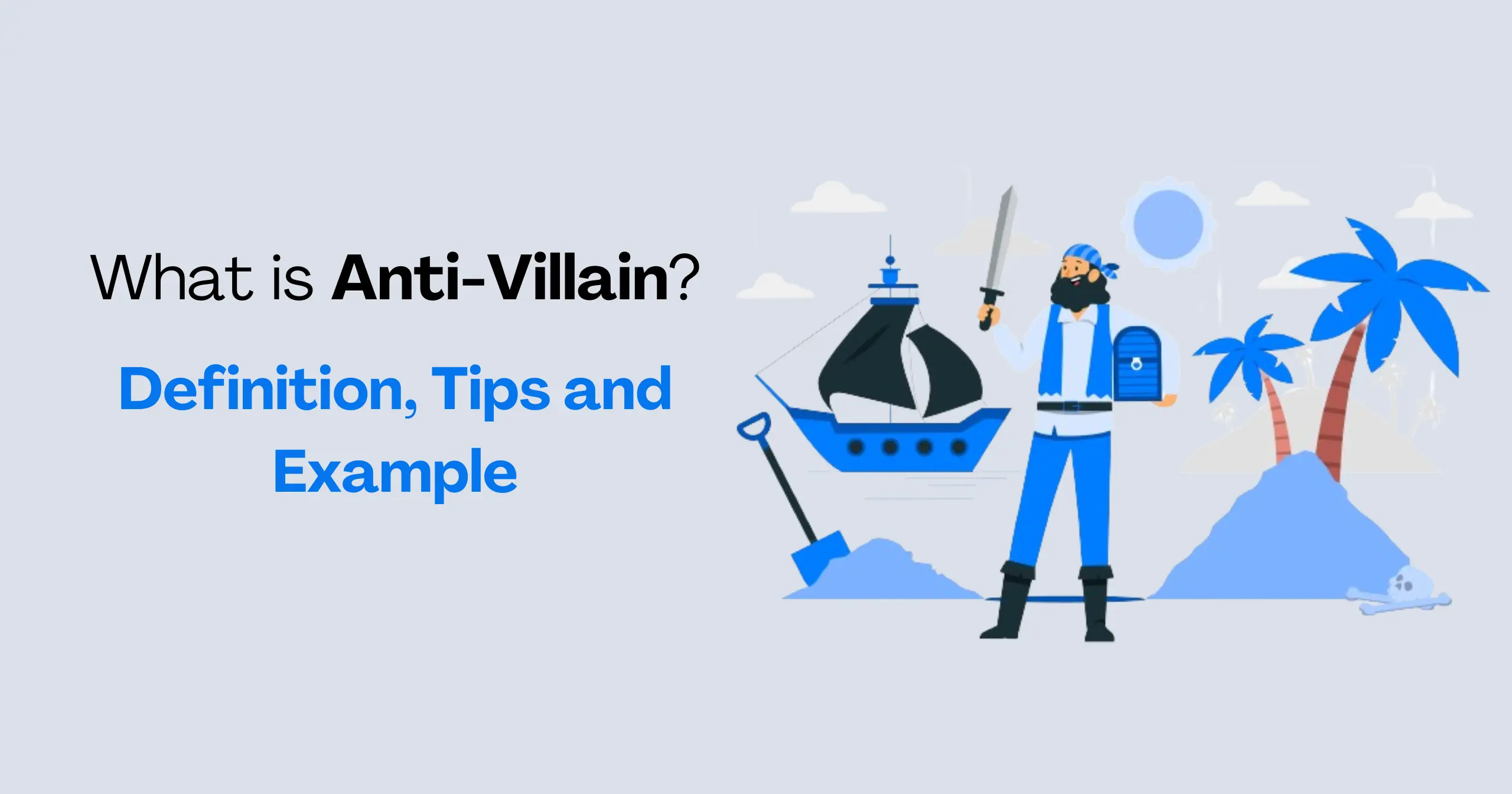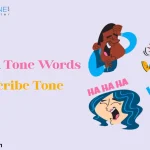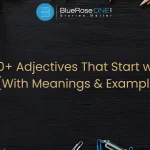Characters in stories can take on a variety of forms, but some of the most fascinating ones are those who don’t easily fit into the hero or villain categories. Presenting the anti-villain, a kind of character that gives stories more nuance and complexity.
Anti-villains are crucial to telling gripping tales because they provide a special fusion of good and evil that enthralls readers. What is an anti-villain, then? Let’s explore and get started.
You may also like: 5 Act Structure: Definition, Examples and More
What is Anti-Villain?
An anti-villain is a character with noble goals or good intentions but who uses questionable methods to achieve them. Unlike traditional villains, anti-villains have moral complexity, making them more relatable. They often challenge the heroes in unique ways, adding depth to the story. Examples include Magneto from X-Men and Thanos from Avengers.
You may also like: What is Plot Structure? Definition with Examples
Characteristics of Anti-Villains
Anti-villains typically exhibit a mix of the following characteristics:
Complex Motivations: One key trait of an anti-villain is their complex motivations. Unlike traditional villains who are evil for the sake of it, anti-villains often have understandable or even noble reasons for their actions.
They might fight for justice, protect loved ones, or pursue a greater good, but their methods can be questionable or harmful. This complexity makes anti-villains intriguing and relatable, as their goals can sometimes align with those of the heroes.
Moral Ambiguity One essential quality of an anti-villain is moral uncertainty. These personalities frequently behave well-intentioned but resort to dubious means to accomplish their objectives.
Anti-villains, in contrast to classic villains, are nuanced and multidimensional, making it difficult to categorize them as exclusively good or evil. Even though readers don’t always agree with their decisions, their ethically dubious behaviors give the plot depth and make for a sympathetic figure.
Sympathetic Traits: A sympathetic quality helps an anti-villain become relevant to the viewer. These individuals typically have heroic motivations or a tragic past that justifies their deeds.
They may exhibit kindness, sensitivity, or a strong sense of justice despite their poor tactics. The anti-villain gains depth from this intricacy, which makes it harder to fully criticize their deeds and makes for a more interesting and complex story.
You may also like: Anti Hero vs. Traditional Hero: What’s the Difference? Book Cover Sizes: What are the Right Dimensions for Your Book?
Types of Anti-Villains
The Well-Intentioned Extremist
Despite employing drastic or dangerous measures, this kind of anti-villain really feels that their acts serve the greater good. Frequently, they have a just cause, but they’re prepared to go against morality to get it.
They are interesting characters that give stories depth because of their nuanced motivations and moral quandaries. Knowing how to interpret a well-meaning extremist facilitates narrative exploration of the thin line separating good and evil.
The Noble Demon
An anti-villain known as the Noble Demon is one who, in spite of their terrible deeds, upholds moral principles or noble attributes. They may differ from conventional villains in that they are motivated by a strong sense of duty, loyalty, or personal morality.
Frequently, their techniques are dubious even when their intentions are clear or even noble. The Noble Demon is an interesting and multifaceted anti-villain because of this complexity.
The Reluctant Villain
One kind of Anti-Villain is the Reluctant Villain, who acts against their own moral convictions or wishes. They frequently find themselves compelled by events beyond their control to play evil characters.
This kind of Anti-Villain exhibits regret and internal anguish in response to their deeds. Because it illustrates the intricacy of human nature and helps readers relate to their difficult decisions, their journey is intriguing.
The Pragmatic Villain
This kind of anti-villain is one who does horrible things but feels that they are required for a bigger cause. In contrast to classic villains, pragmatic villains have rational, practical justifications for their deeds, which lends greater complexity and relatability to their motivations.
Despite their dubious techniques, their efforts are motivated by a desire to attain a positive conclusion. Their character is given depth by this complexity, which sets them apart from other villains.
You may also read: Book Cover Sizes: What are the Right Dimensions for Your Book?
Creating a Compelling Anti-Villain
Understanding Their Motivation
Developing anti-villain motivations is essential to developing a fascinating persona. An anti-villain frequently employs dubious tactics despite having noble motives.
Even if their objectives coincide with the protagonist’s, their deeds distinguish them. Writers can create a multifaceted character by delving into the character’s past and the motivations behind their decisions. This complexity improves the plot as a whole by making the anti-villain more likable and compelling.
Balancing Virtues and Flaws
Balancing virtues and flaws is key to creating a compelling anti-villain. An anti-villain is a character who, despite their noble intentions, adopts questionable methods. Their virtues, like empathy or a sense of justice, make them relatable.
However, their flaws, such as ruthlessness or stubbornness, lead them to make morally ambiguous decisions. This balance makes the anti-villain complex and engaging, allowing readers to understand and even sympathize with their motivations.
Developing Their Backstory
Strong history is necessary to create an engaging anti-villain. Knowing their past makes it easier to understand why people make decisions that are morally dubious. It is imperative to present the experiences that influenced their motivations and perspective.
Maybe they experienced tragedy, betrayal, or a strong conviction in a false philosophy. By examining these components, you may develop an anti-villain that has a genuine, relatable feel to them, which will help the audience understand, if not justify, their actions.
Showing Their Human Side
To create a compelling anti-villain, it’s essential to highlight their human side. This means revealing their emotions, motivations, and vulnerabilities.
An anti-villain is more relatable and engaging when the audience can understand their struggles and see them as more than just antagonists. By showing their fears, desires, and moral dilemmas, you create a complex character that evokes empathy and challenges traditional notions of good and evil.
You may also read: How to Become an Author in 2024: An Essential Guide for Beginners
Anti-Villain vs. Anti-Hero
Key Differences
An Anti-Villain is a complicated and empathetic figure that possesses good intentions or redeeming attributes despite having malevolent ambitions or acts. An Anti-Hero, on the other hand, is the story’s protagonist but lacks the conventional heroic qualities of bravery or morality.
While Anti-Villains frequently arouse empathy in spite of their evil deeds, Anti-Heroes are imperfect heroes who conflate good and evil.
Similarities and Overlaps
Common characteristics between anti-villains and anti-heroes obfuscate the distinction between good and evil. Both of them are complex and sympathetic since they frequently have morally dubious traits. While an anti-hero may fight for good using immoral means, an anti-villain may have noble ideals but employ dubious techniques.
These characters subvert stereotypes and give stories complexity and interest. Comprehending these parallels facilitates the development of more complex stories and multidimensional characters.
You may also read: Foreword vs Preface: Know the Differece
Why Readers Love Anti-Villains
Complexity and Depth
Anti-villains are often a magnet for readers because of their nuance and complexity. Anti-villains, in contrast to classic villains, are human with traits or motivations that inspire empathy or compassion. Their intricacy renders them captivating as personas.
They may have contradictory feelings that make it difficult to distinguish between acts of heroism and villainy, or they may seek lofty objectives via dubious means.
Anti-villains push the bounds of conventional morality, making readers reevaluate their own ideas of what is right and wrong. Characters with defects like Magneto from X-Men or Severus Snape from Harry Potter serve as examples of how these characters can nevertheless have a strong emotional impact on viewers.
Relatability and Sympathy
In stories, Anti-Villains captivate readers because they blur the lines between good and evil, making them more relatable and sympathetic.
Unlike traditional villains who are purely malevolent, anti-villains often have understandable motives or tragic pasts that justify their actions. This complexity makes readers question the nature of morality and empathize with characters who struggle with conflicting principles.
By humanizing their flaws and dilemmas, anti-villains challenge our perceptions and provoke thought, leaving a lasting impression on audiences.
Moral Ambiguity
Moral ambiguity gives anti-villains more nuance and draws readers in. Anti-villains conflate good and evil, in contrast to classic villains who are pure evil.
They frequently justify their dubious behavior with admirable goals or understandable motivations, which elicits sympathy and moral reflection in readers.
This intricacy subverts the traditional hero-villain stereotype, providing a more accurate depiction of human nature in which right and wrong aren’t always obvious. Because of this, anti-villains are likable individuals that elicit strong emotions in viewers.
You may also like: How to Write Faster: 8 Useful Techniques
Tips for Writing Anti-Villains
Avoiding Clichés
Clichés must be avoided while creating an anti-villain character in order to keep them unique and nuanced. Consider nuances that muddy the distinction between heroism and villainy rather than depending solely on features that are predictable, such as pure evil or mysterious motivations.
A well-developed anti-villain questions traditional morality and is frequently motivated by altruistic goals or internal conflicts that provide justification for their deeds.
Through the avoidance of clichés and the embrace of nuanced characterization, authors can craft emotionally charged and resonant anti-villains that add depth and moral quandaries to the story.
Making Their Goals Clear
Making an anti-villain character’s objectives obvious and intelligible to the audience is essential. Anti-villains, in contrast to classic villains, are motivated by noble beliefs or ambitions rather than pure evil.
Their goals may contradict those of the hero, but they are nonetheless pursued. Their character is given depth by this complexity, which encourages empathy and increases the relatability of their acts.
Writers can effectively draw attention to the moral ambiguity that characterizes an anti-villain by clearly describing their motivations and ambitions. This enhances the narrative and keeps readers or viewers interested.
Giving Them a Strong Personal Code
Crafting an anti-villain involves giving them a strong personal code, a set of beliefs or principles that guide their actions, even if those actions might seem antagonistic.
This code often contrasts with societal norms or the hero’s values, adding depth and complexity to the character. Anti-villains, unlike traditional villains driven solely by greed or power, make choices that challenge readers to reconsider what defines right and wrong in a story, making them compelling and thought-provoking figures in narratives.
Ensuring They Challenge the Protagonist
Make sure the Anti-Villain poses a serious threat to the protagonist in order to make them appealing. This entails creating a character that, although having goals that are squarely at odds with the hero’s, yet elicits empathy or understanding from readers.
Anti-villains frequently conflate good with evil, which deepens the tension in the plot. You may increase the tension in the narrative and craft a more captivating plot by providing them with plausible justifications for their conduct and giving significance to their antagonism to the protagonist.
You may also like: What is Plot Structure? Definition with Examples
Common Mistakes to Avoid
Making Them Too Sympathetic
It’s important to find a balance while discussing the typical problem of “Making Them Too Sympathetic” when creating an anti-villain. The purpose of an anti-villain is to arouse empathy in spite of their shortcomings or dubious deeds.
But if their sympathetic qualities are overemphasized, it might become difficult to distinguish them from villains, lessening their impact.
It’s critical to keep a coherent story that gives the audience space to comprehend their point of view while also acknowledging their darker intentions or behaviors. This strategy makes sure the anti-villain keeps the plot interesting without taking away from their adversarial role.
Overcomplicating Their Motivations
It’s important to keep your anti-villain characters motivations simple while creating them. This frequent error might mask the character’s true nature and reduce readers’ ability to relate to them. An anti-villain should behave for rational, even compassionate, reasons that go against the conventions surrounding villainy.
Writers can craft interesting anti-villains that give depth and moral ambiguity to their stories and connect with readers on a deeper level by keeping their motivations obvious and grounded in human desires or beliefs.
Neglecting Their Villainous Actions
Neglecting their evil deeds is a common mistake made while depicting an anti-villain. In contrast to classic villains who take great pleasure in committing terrible deeds, anti-villains frequently engage in morally dubious behavior and offer arguments that make us question our morality.
It is imperative that we do not minimize these acts or overly sanitize their conduct. This runs the risk of destroying the nuance that makes an anti-villain unique. Instead, highlight how their competing interests and the hazy boundaries between right and wrong they traverse give their characters more nuance and draw in viewers.
Conclusion
Anti-villains, who provide a rich combination of complexity, depth, and moral ambiguity, are an essential component of contemporary storytelling. Writers may craft intriguing anti-villains that engage and challenge audiences by comprehending their motivations, striking a balance between their virtues and defects, and steering clear of frequent mistakes.
















